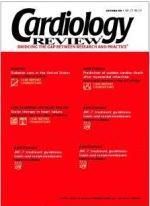Publication
Article
Cardiology Review® Online
Why are diabetic patients more vulnerable to cardiac events after revascularization?
It is increasingly apparent that diabetic patients comprise a distinct subpopulation with regard to both acute and chronic cardiovascular disease. We as cardiologists have always viewed diabetic patients as having more complex and severe coronary artery disease and worse outcomes after revascularization procedures, both percutaneous and surgical. The reasons for this, however, have not been well defined.
The results reported by Werner (page 17) shed important light on this very significant clinical issue. In this study, the authors sought to explore the reasons for the higher cardiac event rates in diabetic patients with a history of coronary artery disease treated with percutaneous coronary interventions. It is an undisputed fact that these patients have a higher incidence of readmission to the hospital with myocardial infarction or acute coronary syndromes. The authors focused on the possibility that impaired coronary collateral recruitment after reocclusion or restenosis of a coronary artery previously intervened upon (usually stented) was the responsible event. To test this hypothesis, the authors went beyond angiography and deployed microsensor technology such as the Doppler flow wire and pressure wires to study this phenomenon.
In 90 consecutive patients who underwent successful recanalization of a total occlusion of a coronary artery, the authors measured collateral function before recanalization (angioplasty and stenting) and then 30 minutes afterwards with balloon reocclusion of the artery. By this method, the recruitment of collateral vessels in the coronary artery tree could be investigated. The study patients were divided into diabetic (one third) and nondiabetic patients. To quantitatively measure collateral status, the authors calculated a resistance index for collateral flow. This index is defined as the aortic pressure minus the distal coronary pressure (by the pressure wire) divided by distal coronary flow velocity as determined by the Doppler flow wire. Thus, a lower distal coronary pressure measured by this technique results in a higher resistance index. A higher resistance index indicates more impairment in collateral function and recruitment.
Briefly, the results were as follows: In patients who had totally occluded coronary arteries of less than 3 months’ duration, there was a significant difference in collateral recruitment after balloon reocclusion between diabetic and nondiabetic patients. This was not seen in patients with chronic total occlusions of greater than 3 months’ duration. The baseline indices for collateral function were similar between the diabetic and nondiabetic groups.
The clinical implication is that the rapid recruitment of preformed collaterals for the protection of myocardium during an acute or sub-acute coronary reocclusion is significantly impaired in patients with diabetes. This would lead to less protection against cardiac events such as myocardial infarction. The difference in collateral recruitment may be due to impaired endothelial function in diabetic patients which, as the authors point out, controls the adaptation of vascular conductance to increased demands, such as acute ischemia. Thus, impaired microvascular function, together with impaired ability for collateral recruitment, may be the primary reason our diabetic patients are at higher risk for cardiac events after coronary angioplasty and stent placement. The difference in collateral resistance index and recruitment of collateral function in patients with total occlusions of less than 3 months’ versus greater than 3 months’ duration explains why diabetic patients are more vulnerable during the early to mid time period postintervention, when restenosis is most prevalent.
Conclusion
As a final thought regarding the clinical significance of this study, we may need to provide increased surveillance of diabetic patients postintervention. Perhaps an enhanced schedule of clinical follow-up or noninvasive stress testing may be appropriate in diabetic versus nondiabetic patient populations.
